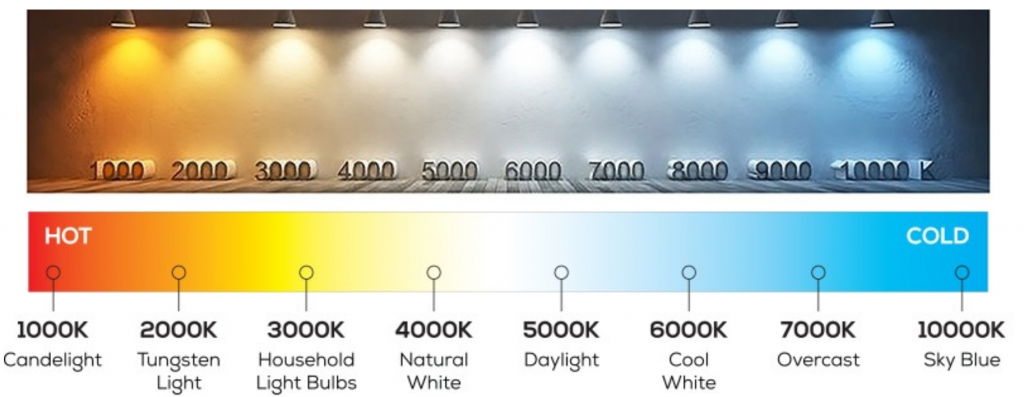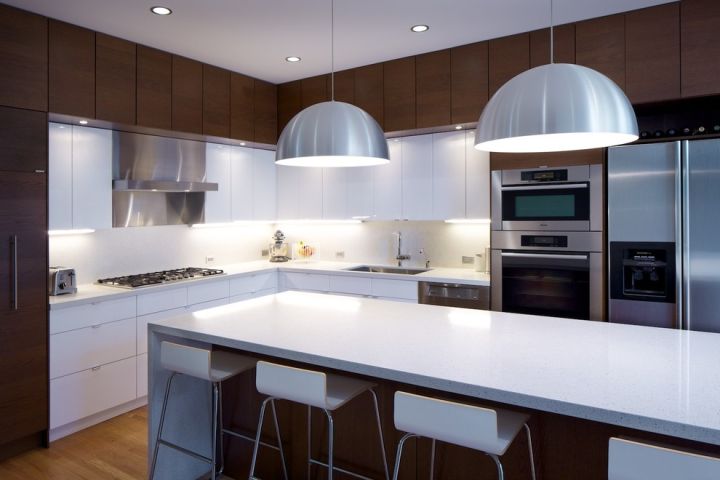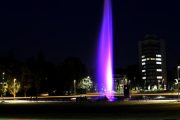Lighting quality refers to whether the lighting source meets the lighting indicators such as visual function, visual comfort, safety, and visual beauty.
The correct application of lighting quality indicators will bring a new experience to your lighting space, especially in the LED lighting era, where the performance of lighting quality is extremely important. The use of lighting quality indicators to purchase LED light source products will bring more lighting effects with half the effort.
Below we respectively introduce the main indicators of lighting quality.
1. Color temperature
It is the light color of white light. It distinguishes whether the light color of white light is reddish or bluish. It is expressed by absolute temperature and the unit is K (Kelvin). Usually the color temperature range of indoor lighting is 2800K-6500K.
The most typical illuminating white light is sunlight. As we all know, sunlight is a mixture of multiple colors of light. Among them, the most important light is red, green and blue.
White light uses the color temperature index to describe the light color. When there are many blue components in the white light, the light color of the white light tends to be blue (cold, such as the sun at noon in the northern winter). When the white light contains more red light components, the white light will be reddish (warmer, such as morning and evening sunlight). Color temperature is the only way to express the color of white light.
The white light of the artificial light source is also formed by mixing light of multiple colors. For artificial light sources, we also use color temperature to describe the light color of white light; for physical analysis of white light. We usually use the method of spectral analysis. The spectral analysis of white light requires special instrument testing and production.
The spectrum of sunlight is rich and full. Incandescent lamps and LED lamps in artificial light sources have better spectral distributions than high-pressure sodium lamps and fluorescent lamps. The spectrum of fluorescent lamps contains ultraviolet components that are harmful to the human body, and incandescent lamps will be eliminated due to high energy consumption. LED light source will be the leading product of lighting source.
When describing the color of white light, many people use warm white light, natural white light, daylight white light and cool white light to classify. For ensuring the quality of lighting, this classification range is too large, and color temperature should be used to describe white light. The color temperature distinction of international standards should be based on the CIE1931 chromaticity diagram.
What color temperature is used for indoor lighting is to match the basic hue of interior decoration. The correct use of white light color temperature can greatly enhance the effect of interior decoration. The use of color temperature lighting suitable for decorating colors is an important method to ensure the quality of lighting. The color temperature of the light source should be considered comprehensively with indoor walls, floors, furniture, decorations, and the purpose of the room. In addition, the blue light hazard produced by the light source must also be considered, and low color temperature lighting should be used as far as possible for the elderly and children.
Different color temperatures have a certain impact on people’s emotions. Warm colors will make people feel at ease, and cool colors will make people think clearly. Patients suffering from autism and mental depression should not live for a long time in an environment above 4000K. Long-term use of a color temperature above 6500K may cause macular degeneration in the retina of the human eye. When selecting the color temperature of the light source, careful consideration is required.
2. Color rendering
It is the degree of restoration of the surface color of the illuminated object by the illuminating light source. It is expressed by the color rendering index Ra. The range of Ra is from 0-100. The closer the value of Ra is to 100, the higher the color rendering and the better the color reproduction on the surface of the illuminated object. The color rendering of the light source requires professional instrument testing.
It can be seen from the solar spectrum that the solar spectrum is the most abundant and the light source with the best color rendering. The color rendering of artificial light sources is always lower than that of sunlight, so the best way to identify the color rendering of artificial light sources is to contrast with sunlight. The easiest way is to compare the color of the palm or face under the sunlight and the artificial light source. The closer to the color under the sunlight, the better the color rendering. You can also face the light source with the palm of your hand and look at the color of the palm. If the color of the palm is gray or yellow, the color rendering is not good. If the color of the palm is blood red, the color rendering is normal.
For LED light sources, Ra can be roughly divided into 3 levels, Ra is less than 69, Ra is between 70-79, and Ra is greater than 80. For high-quality indoor lighting, light sources with Ra greater than 80 should be used.
The international standard is the CIE test standard. For LED light sources, the general color rendering index Ra cannot reasonably reflect the color rendering performance of LED lighting sources, and CIE has not provided new test standards. For users who pursue high color rendering ability, please refer to the Planck curve in the CIE1931 chromaticity diagram.
If you want to buy LED products with high color rendering, it is recommended that buyers do a color blindness test. People with color blindness cannot buy lighting sources with high color rendering.
Color blindness, also known as “Dalton’s disease”, color blindness is the inability of the human eye to distinguish certain colors, and color objects will be lacking in color. Color blindness is more common in red-green blindness, and blue blindness and total color blindness are rare. When choosing a lighting source, you must first test whether you have color blindness, otherwise you will not be able to buy a high-quality lighting source.
When purchasing lighting sources, we hope that the higher the color rendering, the better. However, the luminous efficiency of the light source with high color rendering property will decrease, and the power consumption of the light source will increase. For less important occasions, consider reducing the color rendering requirements, such as staircase aisles. For LED light sources, the cost of LEDs with high color rendering is also high. Light sources with high color rendering properties are relatively good. By choosing LED light sources with high color rendering properties, it is also one of the simple ways to identify high-quality lighting products.
Color rendering is an important indicator of lighting quality. A lighting space with high color rendering will make people feel that the levels are clear, the colors of the items are gorgeous, and the visual beauty is achieved.
3. The illuminance value of the light source
Illuminance is the luminous flux of the light source shining on the unit area of the illuminated object. It indicates the degree of brightness and darkness of the surface of the illuminated object, expressed in Lux (Lx). The higher the illuminance value of the illuminated surface, the brighter the object is illuminated.
The magnitude of the illuminance value has a lot to do with the distance from the light source to the illuminated object. The farther the distance, the lower the illuminance value. The illuminance value is also related to the light distribution curve of the luminaire. The smaller the light output angle of the luminaire, the higher the illuminance value, and the greater the light output angle of the luminaire, the lower the illuminance value; the illuminance value needs to be tested by a special instrument.
From a photometric point of view, luminous flux is the main indicator. As a lighting product, it mainly reflects the brightness of the surface of the illuminated object. It is more accurate to use the illuminance value to describe the lighting effect. The illuminance value of indoor lighting reflects the brightness and darkness of indoor lighting. Too high illuminance and too low illuminance have an impact on the health of human eyes. Therefore, the illuminance value of indoor lighting needs to refer to international standards. According to the illuminance value recommended in this table, there will be no too high or too low illuminance.
4. The light distribution curve of the lamp
The indoor lighting effect is related to the layout of the lamps and the light distribution curve of the lamps. A good lighting effect is reflected in the reasonable layout of the lamps and the correct application of the light distribution of the lamps. The layout of the lamps and the light distribution of the lamps determine the visual function and visual comfort of the indoor lighting, reflecting the three-dimensional and layered sense of the lighting space. Among them, the proper light distribution application of the lamps can improve the lighting quality of the entire lighting space.
The role of lamps is to fix and protect the light source, as well as to decorate and beautify the environment. Another purpose of the lamp is to redistribute the light output of the light source so that the light of the light source outputs light according to the light output angle of the lamp design. This is called the light distribution of the lamp. The light distribution curve of a lamp describes the light output form of the lamp. The smaller the light distribution angle, the brighter it will make people feel. The light distribution curve of the lamp is tested by a special instrument.
(To Be Continued)




